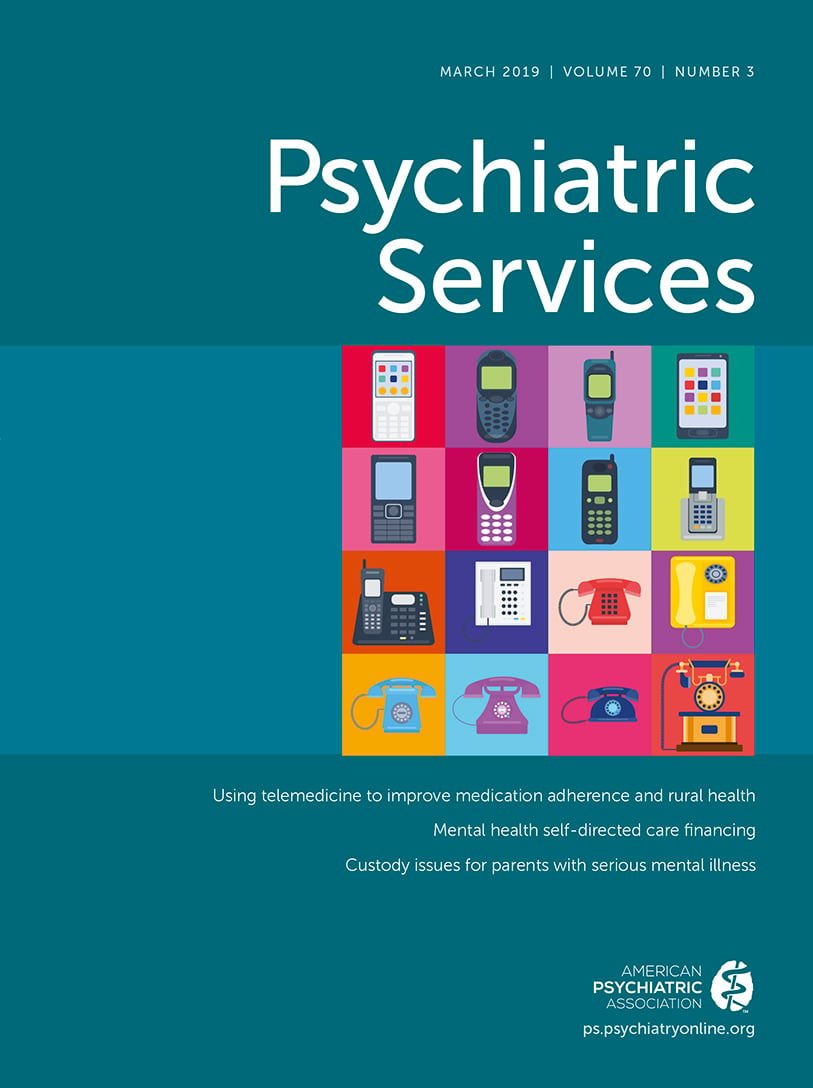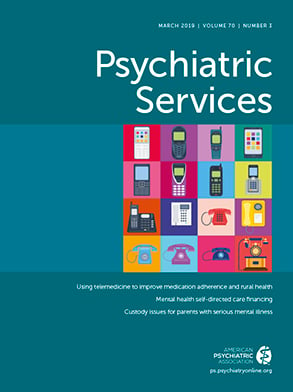Our group developed a telemedicine concept in 2009 based on standardized telephone calls and text messages for patients with anxiety and mood disorders, and we found positive effects on symptom severity for the intervention group (
4,
5). On the basis of these results, we developed an intervention in a randomized clinical trial that used structured telephone calls for individuals with schizophrenia or bipolar disorder to improve medication adherence. Medication adherence was the primary outcome variable; to measure it, we used the German version of the Medication Adherence Report Scale (MARS-D), which is a valid self-report questionnaire to measure nonadherence (
6). We hypothesized that after 6 months the intervention group would have better medication adherence, compared with the control group receiving usual care.
Methods
Data were obtained from a randomized controlled longitudinal trial—“Post stationary telemedical care of patients with severe psychiatric disorder” (Tecla). Tecla was approved by the Ethics Committee of the University Medicine Greifswald and is registered at the German Clinical Trials Register. A comprehensive description of the study protocol for Tecla, including the recruitment procedure and intervention, was published elsewhere (
6).
Participants were recruited in three psychiatric hospitals from either day care units or inpatient wards from January 2015 to October 2017. Inclusion criteria were age 18 or older and a diagnosis of schizophrenia or bipolar disorder. Patients who were not prescribed antipsychotic medication were excluded, as were those with suicidal tendencies, those who were unreachable by phone, and those with scheduled inpatient treatments within the next 6 months. No selection was done regarding the status of adherence. All participants provided written informed consent.
In a first step, all patients who had a physician’s diagnosis of schizophrenia or bipolar disorder were recruited for the baseline assessment. The diagnosis was confirmed by the German version of the Structured Clinical Interview for DSM-IV Axis I Disorders (SCID) (
7). Patients whose symptoms did not meet diagnostic criteria were excluded. After the baseline assessment, participants were randomly assigned to the intervention or control group. Follow-up assessments by telephone were conducted at 3 and 6 months. Data documentation was conducted on the basis of eCRFs (electronic case report forms) with an IT-supported documentation system (
8).
After discharge from the hospital, the intervention group received proactive, regular telephone calls every second week for 6 months from three specially trained nurses. The telephone calls consisted of standardized and individualized parts (
Table 1). The standardized parts included questions concerning medication intake, side effects of the medication, and problems with adherence. If medication nonadherence or intolerable side effects were reported, participants were advised to see a physician. We did not receive feedback from the physician. If suicidal thoughts were expressed, the study`s psychologist and treating physician were directly contacted. The individualized parts of the telephone calls addressed participants’ personal topics. In addition, participants were asked whether they wanted to receive individual text messages referring to a specific topic raised in the telephone calls. Short messages were sent weekly to those who opted to receive text messages. A standardized protocol was applied if the participant could not be reached. (See the
online supplement.) If the participant did not answer for 1 week, the contact was stopped.
Care as usual, which was defined as basic medical care involving occasional visits to a physician to evaluate convalescence, was continued for both groups. The number of visits within the context of basic medical care was not quantified.
All items and the respective answer categories were read to the participants by the interviewer, who used computer-assisted interviews. The baseline assessment was performed in a face-to-face interview to ascertain the diagnosis and sociodemographic variables. The 3- and 6-month follow-ups were conducted via telephone. Medication adherence was a priori defined as the primary outcome variable (
6). A list of secondary outcomes was published elsewhere (
6).
Medication adherence was measured with the MARS-D, which detects nonadherent behavior (
9). The MARS-D consists of five items with 5-point Likert scales (“never” to “always”) that assess how drugs are taken (possible total scores on the MARS-D range from 5 to 25). Because the final MARS-D score was left skewed in our study population, the score was dichotomized, and as in other studies, the cutoff was set at 25 (
10,
11). Participants with a MARS-D score of 25 were considered to be completely adherent, and those with a lower score were considered as nonadherent in at least some way (
10).
A complete list of medications for each patient was retrieved from the patient’s record. For further analyses, psychotropic drug intake was dichotomized (intake versus no intake) for lithium, antidepressants, antiepileptics, benzodiazepines, clozapine, and first- and second-generation neuroleptics. To document intake of multiple drugs, a metric variable was created that counted the number of psychotropic drugs. Intake was assessed without consideration of dosage.
Social desirability was measured with a brief social desirability scale (KSE-G) (
12). The KSE-G measures two aspects of social desirability, the exaggeration of positive qualities and the minimization of negative qualities. Both aspects were assessed with three items, each on a 5-point Likert-scale, and scores on both scales were averaged. Higher scores reflect higher social desirability.
Baseline characteristics were calculated as means with standard deviations for continuous variables and absolute numbers with percentages for categorical variables. Group differences regarding the baseline characteristics and differences between participants with and without 6-month follow-up data were analyzed with t tests for metric variables and chi-square tests for categorical variables. Investigator bias was tested with analyses of variance and with chi-square tests for dichotomous variables. The primary logistic regression aimed to test the treatment effect as measured by the MARS-D score after 6 months (1, adherent; 0, nonadherent), adjusted for age, sex, and the dichotomous MARS-D score at baseline. As a secondary analysis, the effect of the intervention after 3 months as measured by the MARS-D score was tested, adjusted for age, sex, and the corresponding MARS-D values at baseline. In addition, two sensitivity analyses were conducted predicting medication adherence after 3 and 6 months, which controlled for the number of medications, diagnosis, and social desirability.
All four regressions were conducted as intent-to-treat analyses with an imputed data set, which was performed via multiple imputation by chained equations. For the imputation model, all variables that were used in the regression models were included. Twenty imputed data sets were produced by using iterative Monte Carlo Markov chains (MCMC algorithm). Other analyses were performed, as outlined in the protocol, that included only participants who followed the studies protocol (see online supplement). Analyses were performed with SPSS, version 22.0.0.
Results
A total of 134 participants were assessed for eligibility, and 120 were included in the baseline assessment and subsequently randomly assigned to a treatment group. The 6-month follow-up was conducted with 88 participants (intervention group, N=42; control group, N=46). Dropout rates did not differ significantly between groups (see online supplement). The mean±SD age of participants at baseline was 42.9±12.9, and 42% (N=50) were female. The mean number of psychotropic medications taken by participants was 2.28±1.01.
On the basis of the assessment by the treating physician in the hospital and the SCID interview, 96 (80%) participants were classified as having schizophrenia and 24 (20%) as having bipolar disorder. The proportions of participants taking antidepressants (χ2=4.27, df=1, p=.039) and taking antiepileptics (χ2=4.69, df=1, p=.030) differed significantly between groups. The groups did not differ significantly on all other variables (see online supplement).
The identity of the interviewer had no significant effect on outcomes at baseline and follow-up, and no parameters at baseline predicted dropout at 6 months (see online supplement).
On average, participants in the intervention group received 7.22±3.92 intervention telephone calls (range 1–12) and 12.13±11.52 short messages (range 1–40). Twenty patients received only telephone calls.
Logistic regression analysis showed that intervention group participants were significantly more likely than control group participants to be medication adherent at 6 months (odds ratio [OR]=4.11, 95% confidence interval [95% CI]=1.47–11.45, p=.007); the analysis controlled for age, sex, and MARS-D score at baseline. Adjustment for the total number of medications, diagnosis, and social desirability did not affect the results (OR=6.79, 95% CI=1.98–23.28, p=.002) (see online supplement). The intervention effect was observed only after 6 months; no significant effect of the intervention on adherence was found after 3 months when the analysis controlled for age, sex and MARS-D score at baseline. In addition, adjustment for number of medications, diagnosis, and social desirability had no effect on adherence in the intervention group after 3 months (see online supplement).
Discussion
We evaluated a telemedicine intervention provided by trained nurses for patients with severe mental illness in a randomized clinical trial and found positive effects on medication adherence after six months. Nevertheless, some limitations have to be considered. Medication adherence was measured with the MARS-D, a self-report measure (
9). Possible alternatives for measuring adherence are pill counting, measuring serum antipsychotic levels, and electronic monitoring, which have the advantage being more objective (
1). However, these alternatives appear to be more invasive in terms of patient autonomy and self-integrity and can also be manipulated by the patient (
13).
The final MARS-D score skewed left and was therefore dichotomized (25 [perfect score] versus <25) as in prior research (
10,
11). However, it would be beneficial to use a measure that detected degrees of adherence. Furthermore, the MARS-D focuses on overall medication intake. Because some medications, especially antipsychotics, can be more important than others for clinical stability, further studies should measure adherence to various medications separately.
Comparing the results of our study with findings from other telemedicine investigations is challenging because of the heterogeneity regarding the applied telemedicine modalities, the intervention strategy, the duration of telemedicine, and the intended primary outcomes (
1,
14). Overall, patients’ adherence to psychotropic medication seems to be higher if adherence is a central topic of the intervention, if patients receive more therapeutic sessions and the duration of treatment is longer (
2). Developing optimal assessments of medication adherence is a well-known challenge (
14).

